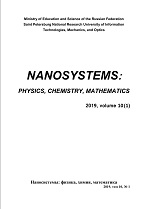|
This article is cited in 2 scientific papers (total in 2 papers)
PHYSICS
Surface plasmon resonance optical sensor for Covid-19 detection
H. A. Zaina, M. Batumalayb, H. R. A. Rahimc, Z. Harithd, M. Yasine, S. W. Harunf
a Photonics Engineering Laboratory, Department of Electrical Engineering, University of Malaya, 50603 Kuala Lumpur, Malaysia
b Faculty of IT, INTI International University, 71800 Nilai, Negeri Sembilan, Malaysia
c Faculty of Electronic and Computer Engineering, Universiti Teknikal Malaysia Melaka, Melaka, Malaysia
d Faculty of Engineering and QS, INTI International University, 71800 Nilai, Negeri Sembilan, Malaysia
e Department of Physics, Faculty of Science and Technology, Airlangga University, Surabaya, Indonesia
f Photonics Research Center, Department of Physics, Faculty of Science, University of Malaya
Abstract:
The transmission of SARS-CoV-2, the novel severe acute respiratory syndrome corona virus have caused the corona virus disease (Covid-19) worldwide pandemic. Overcoming this pandemic requires identifying patients to avoid further spread of the disease. Real-time, sensitive, and cost-efficient methods for detecting the COVID-19 virus are crucial. Optical sensors provide one such means to achieve this, especially using surface plasmon resonance due to its advantages such as high sensitivity and excellent detection limits. In this paper, we propose a sensor for COVID-19 detection which is based on a simple Kretschmann configuration with gold layers and thiol-tethered DNA for the ligand layer. Angle interrogation was used to obtain the sensitivity of this structure using Matlab numerical analysis. The performance of the sensor was investigated with two types of prisms, SF10 and SF11, while varying the gold layer thickness between 45 – 60 nm. This information was then used to determine which combination of prism and gold thickness are ideal for detecting COVID-19 using thiol-tethered DNA. Thiol-tethered DNA layer sensor showed the highest sensitivity of 137 degree/RIU when a SF10 prism was used with a 50 – 60 nm gold layer and thiol tethered DNA layer.
Keywords:
optical sensors, COVID-19, surface plasmon resonance, plasmonic, energy efficiency.
Received: 19.07.2021
Revised: 09.10.2021
Citation:
H. A. Zain, M. Batumalay, H. R. A. Rahim, Z. Harith, M. Yasin, S. W. Harun, “Surface plasmon resonance optical sensor for Covid-19 detection”, Nanosystems: Physics, Chemistry, Mathematics, 12:5 (2021), 575–582
Linking options:
https://www.mathnet.ru/eng/nano1053 https://www.mathnet.ru/eng/nano/v12/i5/p575
|

| Statistics & downloads: |
| Abstract page: | 180 | | Full-text PDF : | 143 |
|



 Contact us:
Contact us: Terms of Use
Terms of Use
 Registration to the website
Registration to the website Logotypes
Logotypes